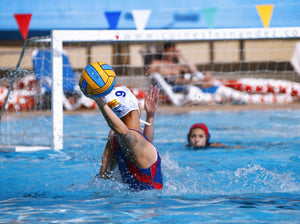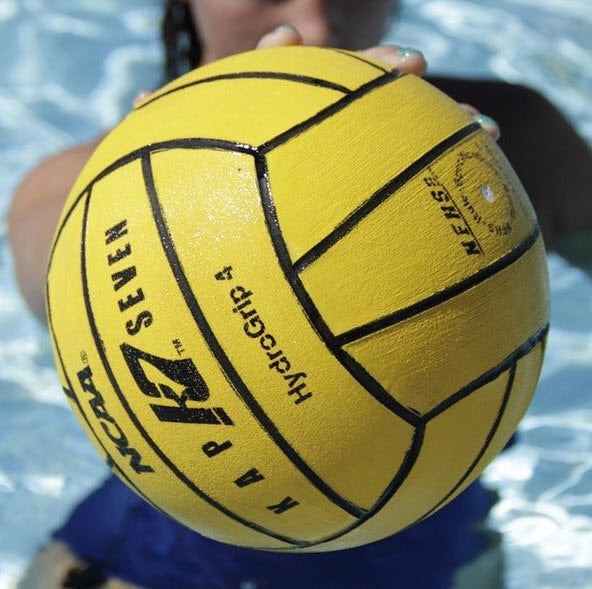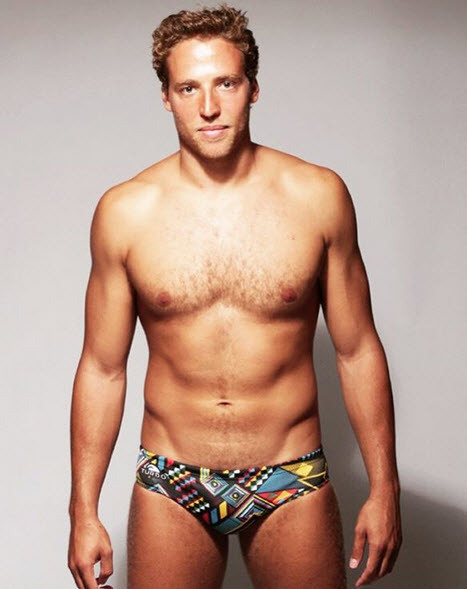Swimming Drills for Water Polo
 It is often said that water polo players are just swimmers who got bored. There's some serious truth behind that statement, since there's hardly a skill more fundamental to water polo than swimming. A good stroke is a valuable asset in water polo, but there are some very important differences between the stroke style of a lap swimmer and that of a water polo player. Swimming drills targeted to water polo players mimic the fast-paced, back-and-forth of a water polo game that no amount of lap swimming ever will. This guide explains some of the best swim conditioning drills that water polo coaches have developed for their players.
It is often said that water polo players are just swimmers who got bored. There's some serious truth behind that statement, since there's hardly a skill more fundamental to water polo than swimming. A good stroke is a valuable asset in water polo, but there are some very important differences between the stroke style of a lap swimmer and that of a water polo player. Swimming drills targeted to water polo players mimic the fast-paced, back-and-forth of a water polo game that no amount of lap swimming ever will. This guide explains some of the best swim conditioning drills that water polo coaches have developed for their players.
Lines
The “lines” swimming drill helps water polo players improve both their heads-up freestyle stroke and ability to change directions quickly:
- The coach should mark off three to seven points along the length of the pool, each at least five feet from the next; these can be cones, chairs, or markings already on the side of the pool like the five meter, the middle, etc.
- The players should start on one end of the pool and swim heads-up freestyle to the first mark. As soon as they reach it, they turn around and swim back to the wall. Once at the wall, they turn around and swim to the second mark.
- As soon as they get to the second mark, they turn around and swim back to the wall again, continuing this pattern until they have swum to and from each of the marks.
This drill can also be done without marks on the side of the pool: players start swimming and change direction each time a coach blows their whistle. They continue swimming back and forth until they reach the opposite wall.
There are plenty of variations for this drill. For example, instead of requiring the players to swim back to the wall each time have them swim to the mark they were just at. That means that their swimming is wall > first mark > wall > second mark > first mark > third mark et cetera, until they reach the other side.
Heads-up Progression
Once players have mastered the basic style of heads-up freestyle, it's time to improve work on endurance and agility. The following progression takes swimmers from standard to heads-up freestyle to more complicated versions of the stroke. The drills cement good heads-up technique and add new dimensions to the stroke. Each drill should last for one to two laps, and can be repeated as many times as the coach sees fit.
- Regular heads-up freestyle
- Heads-up freestyle with exaggerated arms: Extremely high elbows, faster-than-normal stroke, shorter pull.
- Heads-up freestyle with exaggerated kick
- Heads-up freestyle with a ball
- Heads-up freestyle with eggbeater
Players should keep their heads still, facing up and forward. A solid heads-up freestyle technique will include high elbows, a fast kick, and a quick turnover rate.
Sprints & Sprint Tournaments
Starting a practice or a pre-game warm up with a series of sprints is great way to get players loose. Players should line up across the pool. The number of sprints is up to the coach, but a minimum of four is quite standard.
Sprints can include:
- Regular freestyle
- Heads-up freestyle
- Heads-up backstroke
- Heads-up freestyle with the ball
In a sprint tournament, players swim from one end of the pool to the other as fast as possible. The winner of each sprint gets out to rest, while the remaining players have to sprint again. The sprints continue until there are only two players left in the pool. This can be done with the team all at once, or in waves, combining the groups as they get smaller.
If there are too many players to swim a drill at once, players should number off so they can leave in waves. This will give them enough room to perform the drills correctly while still being competitive with the teammates in their group.
Counterattack Lap
The counterattack lap incorporates the various swimming styles that a water polo players uses during a counterattack. To swim a counterattack lap, the players start at one wall and swim heads-up freestyle to the halfway point, looking back every few strokes (as though looking to the goalkeeper for a pass). Once there, they flip onto their back for about five strokes, then onto their stomachs for a heads-up freestyle sprint to the wall.
A simple variation of this drill is to start by having players partner up. One set of players stay at the wall; as soon as their partners hits the halfway point and flip on to their backs, the players by the wall throw a ball towards them. The players with the ball swim heads-up freestyle with the ball to the wall, and their partners do a normal counterattack lap. On the next lap, the partners switch who throws and who receives the pass.
Swim & Kicking Sets
Water polo players should never start a swimming drill by pushing off the wall. Instead, players should tread a couple of feet from the wall and start the lap with a powerful scissor kick, as they would have to in a game. This adds an extra challenge to the workout – no resting on the wall – and improves the power of their scissor kick.
Early on in a water polo season, most coaches focus on conditioning to make sure their players have the endurance needed for a water polo game. In the water, conditioning may mean long-distance swimming or kicking sets. The length of these sets will vary greatly from team to team, depending on age and water polo experience. However, this conditioning phase is important for water polo players at all levels of the game. Lots of back-and-firth mileage gets players used to constantly moving in the water for extended periods of time; the additional muscle that they’ll build will also help to prevent injury in the future.
Swim and kicking sets can be long-distance to improve endurance. Coaches can also use shorter, interval-based sets to improve speed and explosive power. Standard swimming strokes are fine, as using a variety of strokes – freestyle, backstroke, breaststroke, and butterfly as well as the water polo strokes – will help prevent repetitive use injuries. Although swim sets may be longer and more intense at the beginning of a season, it is a good idea to regularly work them into practices to maintain endurance and stroke technique.
Keep on Swimming
Most water polo players prefer water polo practice and training to lap swimming, with good reason:
- Water polo is more social than swimming.
- There is a lot more variety in terms of movement and technique.
- Working on skills like shooting and passing are more engaging than simply swimming back and forth.
However, all water polo players should be encouraged to get in plenty of swimming while they train. Not only will they stay in better shape, but they will continue to improve their stroke, their speed, and their feel for the water. Any water polo player who commits to a regular swimming regimen will easily have an advantage over a player that does not.



